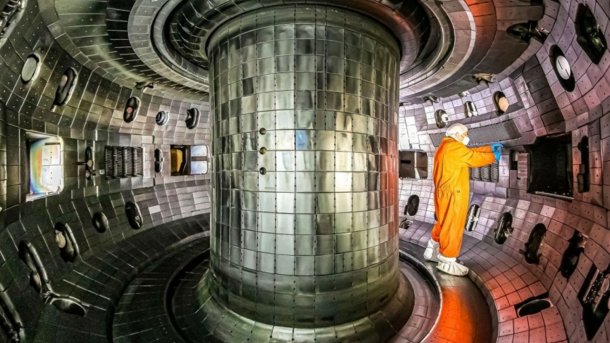Possible breakthrough: nuclear fusion experiment achieves record plasma density
Researchers have generated a plasma density in nuclear fusion experiments with a tokamak reactor that is 20 percent above the limit considered possible.

(Bild: General Atomics)
In fusion experiments, a research team from the US defense and nuclear corporation General Atomics has succeeded in achieving a plasma density in the reactor for 2.2 seconds that is 20 percent above the previously considered possible limit, the so-called Greenwald density. At the same time, they claim to have improved the ability to trap energy in the plasma by 50 percent compared to previous standard procedures.
The Greenwald density is an empirical limit for the maximum stable plasma density in tokamak fusion reactors. It is proportional to the plasma flow and depends on the size and shape of the reactor. If the Greenwald limit is exceeded, there is a risk of instability and collapse of the plasma ("disruption"), which can lead to damage to the reactor. Therefore, in fusion research, the plasma density is carefully kept below this critical limit to ensure safe and stable operation.
For the experiments, the team used the DIII-D tokamak – a nuclear fusion test facility of the U.S. Department of Energy. Tokamaks are donut-shaped chambers in which hot plasma – an ionized gas – is confined with the help of strong magnetic fields. The aim is to fuse atomic nuclei to generate fusion energy. The denser the plasma and the better the energy confinement, the more fusion reactions take place and the higher the amount of energy generated.
Reduced instabilities
The team also succeeded in greatly reducing feared instabilities at the edge of the plasma, so-called edge-localized modes (ELMs). Large ELMs can damage the walls of the reactor. The electron temperature at the divertor, which removes impurities from the plasma, could also be lowered, according to the article published in the journal Nature. Lower temperatures there reduce the erosion of the wall.
According to the team, the key to success was to create a high-pressure difference in the plasma with a strong plasma flow at the same time. This created a kind of barrier that improved the confinement of the plasma and at the same time suppressed turbulent mixing. Computer simulations had confirmed the importance of the interplay between high plasma pressure and optimized current distribution for this promising operating mode.
With their experiment, the researchers were able to show that short-term tokamak operation is possible with high plasma density, improved energy confinement and at the same time only small ELMs. This represents an important step towards a working point for future fusion power plants and thus towards efficient and economical energy generation through nuclear fusion.
Further investigations by the researchers indicate that an effect known as "alpha stabilization" plays a key role. This occurs at high plasma pressure and an optimized distribution of the plasma flow. The "high poloidal beta" operating mode used in the experiment is therefore particularly suitable for achieving these favorable conditions. However, to exploit the full potential for future power plants, the operating mode shown must be further optimized, especially with regard to long-term operation and the use of tungsten as a wall material in the reactor, the research team writes.
Further successes
Recently, the South Korean research reactor KSTAR (Korea Superconducting Tokamak Advanced Research) also celebrated a successful step in fusion energy research. An experiment by the Korea Institute of Fusion Energy and the National Research Council of Science & Technology achieved ion temperatures of 100 million degrees Celsius for 48 seconds; the plasma in "high confinement mode" was stable for over 100 seconds. The aim is to maintain the plasma at over 100 million degrees for up to 300 seconds, which is to be supported by further technical improvements and the use of artificial intelligence.
(vza)